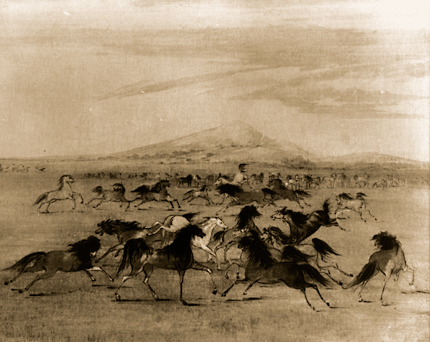On 14 August 1805, Meriwether Lewis commented on the Lemhi Shoshones‘ herds: “Most of them are fine horses. Indeed, many of them would make a figure on the South side of James River or the land of fine horses. I saw several with Spanish brands on them, and some mules which they informed me that they had also obtained from the Spaniards.”[1]In 1800 there may have been as many as two million wild horses roaming the Southwest.
Catlin’s 1834 Description
In 1834, artist George Catlin accompanied a regiment of 800 mounted dragoons out of Fort Gibson, near the present city of Tulsa, Oklahoma, bound for Comanche country on the upper Red River. There he saw large herds of wild horses, and made this sketch, which he later turned into his painting, Wild Horses at Play.
“The wild horse of these regions,” Catlin wrote, “is a small, but very powerful animal; with an exceedingly prominent eye, sharp nose, high nostril, small feet and delicate leg; and undoubtedly, have sprung from a stock introduced by the Spaniards, at the time of the invasion of Mexico; which having strayed off upon the prairies, have run wild, and stocked the plains from this [region] to Lake Winnepeg [sic], two or three thousand miles to the North.”
Catlin described the Indians’ technique for catching and taming wild horses:
The usual mode of taking the wild horses is, by throwing the laso whilst pursuing them at full speed, and dropping a noose over their necks, by which their speed is soon checked, and they are “choked down.” The laso is a thong of rawhide, some ten or fifteen yards in length, twisted or braided, with a noose fixed at the end of it; which, when the coil of the laso is thrown out,drops with great certainty over the neck of the animal . . . . He instantly dismounts, leaving his own horse, and runs as fast as he can, letting the laso pass out gradually and carefully through his hands, until the horse falls for want of breath, and lies helpless on the ground; at which time the Indian advances slowly towards the horse’s head, keeping his laso tight upon its neck, until he fastens a pair of hobbles on the animal’s two forefeet, and also loosens the laso (giving the horse chance to breathe), and gives it a noose around the under jaw, by which he gets great power over the affrighted animal, which is rearing and plunging when it gets breath; and by which, as he advances, hand over hand, towards the horse’s nose, he is able to hold it down and prevent it from throwing itself over on its back, at the hazard of its limbs. By this means he gradually advances, until he is able to place his hand on the animal’s nose, and over its eyes; and at length to breathe in its nostrils, when it soon becomes docile . . . so that he has little else to do than to remove the hobbles from its feet, and lead or ride it into camp.[2]George Catlin, Letters and Notes on the Manners, Customs, and Conditions of the North American Indians, Written during Eight Years’ Travel (1832-1839) amongst the Wildest Tribes of Indians in … Continue reading
Pryor Mountain Wild Horse Range
Pryor Mountain Wild Horse Herd
© 2003 Mike Dreesman, videographer.
See also Pryor Mountain Horses.
Today there are only two areas reserved by Federal government for wild horses. One is on the Nellis Air Force Base in Nevada; the other, shown here, is in the mountains in south-central Montana that are named for Sergeant Nathaniel Pryor. The herd consists of approximately 180 genetically unique horses of Colonial Spanish-American heritage, originating in Portugal and Spain, that have roamed freely throughout the Pryor Mountains since at least the time of the Expedition. Horses were brought to the Americas by Spanish explorers, who landed at Vera Cruz in 1519, but it was nearly 200 years thereafter that the Shoshone Indians became the first Plains tribes to acquire them, in 1690. Another 20 years past before the Nez Perce got them, about 1710. Slowly but steadily the other great tribes began to develop their own herds: the Crows about 1730, the Blackfeet and the Mandans at mid-century, followed by the Sioux and the Plains Cree in 1770.
Notes
| ↑1 | In 1800 there may have been as many as two million wild horses roaming the Southwest. |
|---|---|
| ↑2 | George Catlin, Letters and Notes on the Manners, Customs, and Conditions of the North American Indians, Written during Eight Years’ Travel (1832-1839) amongst the Wildest Tribes of Indians in North America (2 vols; London, 1844; reprint, Dover, 1973), II:58-59. |

